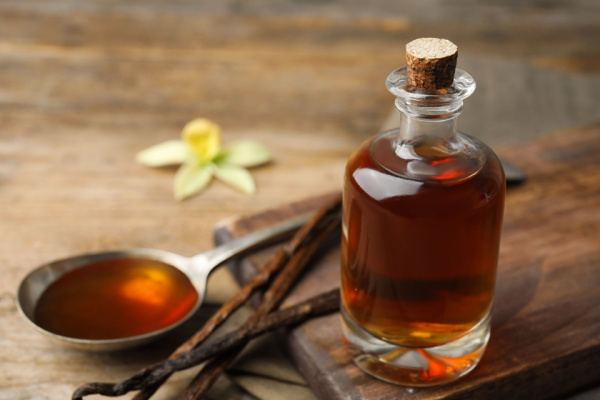If you bake a lot, you’re constantly doling out vanilla extract—a teaspoon in chocolate chip cookies one day, a tablespoon in vanilla ice cream base the next. But have you ever stopped to ask: Where does vanilla extract come from? Or, wait a minute, what even is vanilla?
So, what even is Vanilla, anyway?
To understand vanilla extract, you’ve got to know the basics about vanilla. As Bon Appetit reports, a vanilla bean is actually not a bean at all—it’s the fruit of orchids in the genus Vanilla. Those vanilla orchids only grow in a very small subsection of the world, with Madagascar producing a whopping 80%. Every step of the labor-intensive harvesting process—from the pollination to the harvest to the curing (that is, the transformation of fat green vanilla pods into skinny black beans)—is done by hand! For all of these reasons, the demand greatly exceeds the supply, hence vanilla’s standing as the world’s second most expensive spice (around $270 a lb.), behind saffron.
But why is vanilla a prized addition? What does it bring to the table? The comforting flavors in vanilla (toasty, musky, floral, or even smoky and earthy) enhance nearly any dessert, making it endlessly versatile. Its caramelly richness makes warm, deep flavors—coffee, chocolate, hazelnut, brown butter, and cinnamon—cozier and bright flavors—like citrus, hibiscus, rosemary, and berry—sharper and more pronounced.
Where does Vanilla Extract come from?
Vanilla extract—the kind that explicitly says “pure vanilla extract” on its label—is made by soaking vanilla beans in an alcohol solution to “extract” (get it?) all of their flavor compounds. According to the FDA, “pure” vanilla extract must be at least 35% alcohol with a minimum of 100 grams of vanilla beans per liter. When you’re shopping for high-quality extract, check the ingredients: It should only list vanilla beans, alcohol, and water, with no additives like sugar or artificial colors or flavors.
The problem is, due to fancy marketing/labeling, many people think they’re buying “pure” vanilla extract when they are, in fact, buying the imitation.
Where does imitation vanilla come from?
According to Bon Appetit, a whoppig ninety-nine percent of the world’s vanilla extract is fake imitation vanilla that’s not a product of the plant itself. Instead, it’s flavored primarily with synthetic vanillin (a lab-produced version of the same chemical compound that occurs naturally in real vanilla). Typically labeled as “vanilla essence,” this artificial vanilla is usually derived from, uh, less-than-organic material (like petroleum). While it mimics vanilla’s smell, many would argue that it doesn’t come close to capturing all of the complex floral and woodsy notes that result from the myriad of other flavor compounds in true vanilla.
This isn’t to say that imitation vanilla doesn’t have a purpose! It’s the way more economical choice, and you might not even be able to detect it as an imposter in desserts that are packed with lots of other flavorful ingredients or in baked goods that spend a significant time in the oven.
What’s this about beaver butts?
When it comes to imitation vanilla, there’s a whooole lot of talk about beaver anal glands. Beaver castoreum (the goo-like vanilla-scented secretion that comes from beavers’ castor sacs, located, yes, in close proximity to their anal glands) has been used as a food additive for much of the last century. It’s recognized as safe by the FDA and could, in theory, sneak onto ingredients lists under the label of “natural flavorings.” But the truth is you’re actually not likely to encounter it in your desserts. According to The Atlantic, global production is extremely limited, and it’s more commonly found in perfumes and cosmetics. When it comes to your average supermarket purchases, there’s no need to fret: Nearly all vanilla extracts are vegan—even the imitation ones.
When to go Extract and when to go Bean?
You may be tempted to swap out a pricey vanilla bean for the (slightly) more economical vanilla extract. But sometimes the seeds are worth it. When vanilla is the sole flavor and those signature flecks will be in the spotlight (think pudding, ice cream, crème brûlée, shortbread), splurge and buy the bean or use paste. But when vanilla is a backdrop to the star elements (in spice cookies, chocolate cake, and fruit pie filling, for example), save a buck and go with extract.
—
Photo Credit: New Africa / Shutterstock.com
